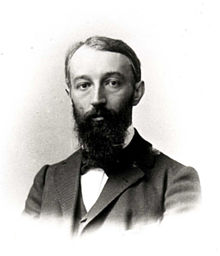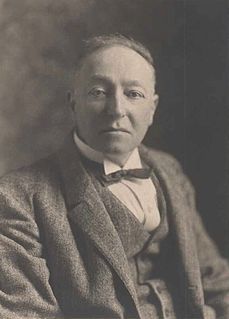Related Research Articles

Christian Felix Klein was a German mathematician and mathematics educator, known for his work with group theory, complex analysis, non-Euclidean geometry, and on the associations between geometry and group theory. His 1872 Erlangen program, classifying geometries by their basic symmetry groups, was an influential synthesis of much of the mathematics of the time.

Marius Sophus Lie was a Norwegian mathematician. He largely created the theory of continuous symmetry and applied it to the study of geometry and differential equations.
In mathematics, the uniformization theorem says that every simply connected Riemann surface is conformally equivalent to one of three Riemann surfaces: the open unit disk, the complex plane, or the Riemann sphere. The theorem is a generalization of the Riemann mapping theorem from simply connected open subsets of the plane to arbitrary simply connected Riemann surfaces.
In mathematics, a Fuchsian group is a discrete subgroup of PSL(2,R). The group PSL(2,R) can be regarded equivalently as a group of isometries of the hyperbolic plane, or conformal transformations of the unit disc, or conformal transformations of the upper half plane, so a Fuchsian group can be regarded as a group acting on any of these spaces. There are some variations of the definition: sometimes the Fuchsian group is assumed to be finitely generated, sometimes it is allowed to be a subgroup of PGL(2,R), and sometimes it is allowed to be a Kleinian group which is conjugate to a subgroup of PSL(2,R).

Eduard Study, more properly Christian Hugo Eduard Study, was a German mathematician known for work on invariant theory of ternary forms (1889) and for the study of spherical trigonometry. He is also known for contributions to space geometry, hypercomplex numbers, and criticism of early physical chemistry.

Carl Gottfried Neumann was a German mathematician.

Hermann Hankel was a German mathematician. Having worked on mathematical analysis during his career, he is best known for introducing the Hankel transform and the Hankel matrix.

Franz Ernst Neumann was a German mineralogist, physicist and mathematician.
In mathematics, an automorphic function is a function on a space that is invariant under the action of some group, in other words a function on the quotient space. Often the space is a complex manifold and the group is a discrete group.

In mathematics, a Kleinian group is a discrete subgroup of the group of the Möbius transformations. This group, denoted PSL(2, C), is the quotient group of the 2 by 2 complex matrices of determinant 1 by its center, which consists of the identity matrix and its product by −1. The group PSL(2, C) has several natural representations: as conformal transformations of the Riemann sphere; as orientation-preserving isometries of the 3-dimensional hyperbolic space H3; and as orientation-preserving conformal transformations of the open unit ball B3 in R3. So, a Kleinian group can be regarded as a discrete subgroup acting on one of these spaces.

Rudolf Friedrich Alfred Clebsch was a German mathematician who made important contributions to algebraic geometry and invariant theory. He attended the University of Königsberg and was habilitated at Berlin. He subsequently taught in Berlin and Karlsruhe. His collaboration with Paul Gordan in Giessen led to the introduction of Clebsch–Gordan coefficients for spherical harmonics, which are now widely used in quantum mechanics.

Leo Königsberger was a German mathematician, and historian of science. He is best known for his three-volume biography of Hermann von Helmholtz, which remains the standard reference on the subject.

In mathematics, a Schottky group is a special sort of Kleinian group, first studied by Friedrich Schottky (1877).

Oskar Bolza was a German mathematician, and student of Felix Klein. He was born in Bad Bergzabern, Palatinate, then a district of Bavaria, known for his research in the calculus of variations, particularly influenced by Karl Weierstrass' 1879 lectures on the subject.

Karl Emanuel Robert Fricke was a German mathematician, known for his work in complex analysis, especially on elliptic, modular and automorphic functions. He was one of the main collaborators of Felix Klein, with whom he produced two classic, two-volume monographs on elliptic modular functions and automorphic functions.

Ludwig Schlesinger, was a German mathematician known for the research in the field of linear differential equations.

Alexander Wilhelm von Brill was a German mathematician.
In the mathematical theory of Kleinian groups, Bers slices and Maskit slices, named after Lipman Bers and Bernard Maskit, are certain slices through the moduli space of Kleinian groups.
Martin Krause was a German mathematician, specializing in analysis.

Friedrich Georg Schilling was a German mathematician.
References
- Fricke, Robert; Klein, Felix (1897), Vorlesungen über die Theorie der automorphen Functionen. Erster Band; Die gruppentheoretischen Grundlagen. (in German), Leipzig: B. G. Teubner, ISBN 978-1-4297-0551-6, JFM 28.0334.01
- Fricke, Robert; Klein, Felix (1912), Vorlesungen über die Theorie der automorphen Functionen. Zweiter Band: Die funktionentheoretischen Ausführungen und die Anwendungen. 1. Lieferung: Engere Theorie der automorphen Funktionen. (in German), Leipzig: B. G. Teubner., ISBN 978-1-4297-0552-3, JFM 32.0430.01
- Maskit, Bernard (1988), Kleinian groups, Grundlehren der Mathematischen Wissenschaften [Fundamental Principles of Mathematical Sciences], vol. 287, Berlin, New York: Springer-Verlag, ISBN 978-3-540-17746-3, MR 0959135